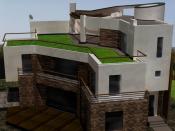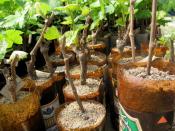Search
Login
Installation of a wet facade
Following the path of building a new house, the head of the owner swells from various tasks. Finishing and warming the future masterpiece are two issues that can be solved with the use of a wet facade.
Content
- What is a wet facade
- The advantages of a wet facade
- Disadvantages of the wet facade
- Thermal insulation
- Reinforcing layer
- Finish finish
- The installation of a wet facade in stages video
What is a wet facade
New technologies in the construction of country houses include a system external insulation. We consider a wet system, it can be called wet due to the fact that the plaster and adhesive used in the work are diluted with water.
Naturally, after the water evaporates, this system cannot be called wet.
The process of creating such a facade includes a heater in the form of mineral wool or expanded polystyrene - it is attached to the walls with the help of special, high-adhesion glue and dowels.
Then, with the help of fiberglass mesh, the insulation is reinforced and at the final stage all this is covered with decorative plaster.
The advantages of a wet facade
This type of finish has many advantages.
- Firstly, one of the main advantages is that you can finish buildings of any number of storeys and configurations.
- Secondly, wet facade technology, it is possible to use both new and reconstructed buildings.
- Thirdly, if the house does not keep heat well, using the above technology, the house does not need to be rebuilt.
- Fourth, if the project of a new mansion has originally laid the technology of a wet facade - the walls of the future building can be relatively thin. And this reduces financial costs in the construction of the foundation.
- Fifth, external insulation does not reduce the useful area of \u200b\u200bthe house.
- Sixth, wet plastering is good soundproofing.
Disadvantages of the wet facade
The disadvantages include the high cost, which depends on many factors and in each case will be individual.
The main amount of expenses is covered by high-quality insulation and reliable fasteners.
It must be borne in mind that the work is quite laborious, requires experienced installers, of course, and appropriate wages.
In addition, weather conditions must be taken into account, since work is allowed to be carried out at temperatures above +5 degrees Celsius, while the humidity should not exceed 40%.
This is due to the fact that all mortar must dry slowly and evenly.
Thermal insulation
The most important component of a wet facade system is thermal insulation. Mineral wool or polystyrene foam can be used as thermal insulation.
mineral wool
This is the best thermal insulation material for this wet facade.
The positive qualities include high thermal insulation performance.
Mineral wool is durable, has a high anti-fire rating, since even with direct contact with fire, this heat-insulating material does not burn.
The disadvantages include its high hygroscopicity, and absorbing even 5% moisture, it loses up to 50% of its thermal insulation properties.
Conclusion - when purchasing mineral wool, pay attention to the density of the material (120-170 kg. \\ cubic meter), the tensile strength of the upper layer should be at least 15 kPa.
If you purchase high-quality mineral wool, this will not create problems with the preservation of heat in the house in the future and will not create problems when applying a layer of decorative plaster.
Important! High-quality mineral wool should have a water absorption of not more than 1.5%, and the thickness of the insulation should be at least 100 mm.
polystyrene foam
The second heat-insulating agent is polystyrene foam, it can be in the form of foam and extruded.
Polyfoam has a low cost, and extruded polystyrene foam has high thermal insulation (20 mm thick. Extruded polystyrene foam, equal to 400 mm thick masonry in thermal insulation).
The main disadvantage is the high susceptibility to burning, therefore, during construction use a special brand of insulation, pre-treated with flame retardants.
In addition, it should be noted that experts still do not recommend the use of extruded polystyrene foam, as it has low vapor permeability.
The walls covered with such a material do not breathe, in addition, this material has poor adhesion, before applying the adhesive and reinforcing mixture, the smooth surface of the extruded polystyrene foam has to be mechanically incised.
Positive recommendations on the use of this material apply only to concrete substrates (they have minimal vapor permeability, they are not threatened with the formation of fungus and in the future there will be no collapse of the facade system).
Reinforcing layer
The second component in wet facade technology is the reinforcing layer.
This is an adhesive composition based on polymers or polymer cements; in this composition, the mesh is recessed - it allows you to ensure the durability of the entire system.
The mesh should have elasticity, tensile strength, and resistance to alkali (alkali is practically found in every mortar).
An excellent reinforcing layer is a fiberglass mesh, its density is not less than 150 grams per square meter.
High requirements for reinforcement are explained by strong loads in the form of wind, water, temperature changes, soil and building shrinkage, etc.
The ground floor of the building suffers the most from all mechanical influences, therefore, experts, for reliability, recommend the use of reinforced carapace, its density is 200 gr. per square meter.
Alternatively, you can use the usual reinforcing mesh in two layers.
Finish finish
Finishing involves plastering a previously prepared surface.
For such a finish, mineral plaster is used, after drying, it is covered with breathable paints.
Alternatively, you can cover with polymer plasters, which are tinted in bulk.
Important! All finishing materials must have high vapor permeability, if the insulation is wet due to any reason - the moisture from the insulation must evaporate naturally.
Important! Each subsequent layer of the system should have a higher vapor permeability than the previous one.
The installation of a wet facade in stages
The technology of the wet facade involves several stages:
- the wall is previously cleaned of any impurities, it can be brick, concrete, stone or wood;
- after cleaning, soil is applied to the walls, it removes dust and makes the wall evenly absorbing;
- glue is applied to the insulation boards along the contour and center, with spots;
- insulation boards are glued, while the geometry of the walls is controlled by the building level;
- after the glue has dried, with the help of dish-shaped dowels, an additional insulation is fixed;
- to keep warm, insulation boards are laid apart;
- angles are laid on the corners of the reinforcing mesh using glue;
- reinforcement is performed. Glue is applied to the walls, a fiberglass mesh is laid on it, which is resistant to alkali;
- a decorative base layer of plaster is applied to the reinforcing fiberglass mesh.
Important! If a polystyrene foam plate is used in the form of a heater, then polymeric or mineral adhesives are used for reinforcement, and the top coat is made of polymer and mineral plasters. If mineral wool is used as a heater, mineral glue and mineral vapor-permeable silicone and silicate plasters are used.
Important! Acrylic compounds can not be covered with mineral wool, this will destroy the facade.
Having performed such hard work, financially not cheap - you will get a very reliable system, the life of which, according to conservative estimates, reaches 30 years.





